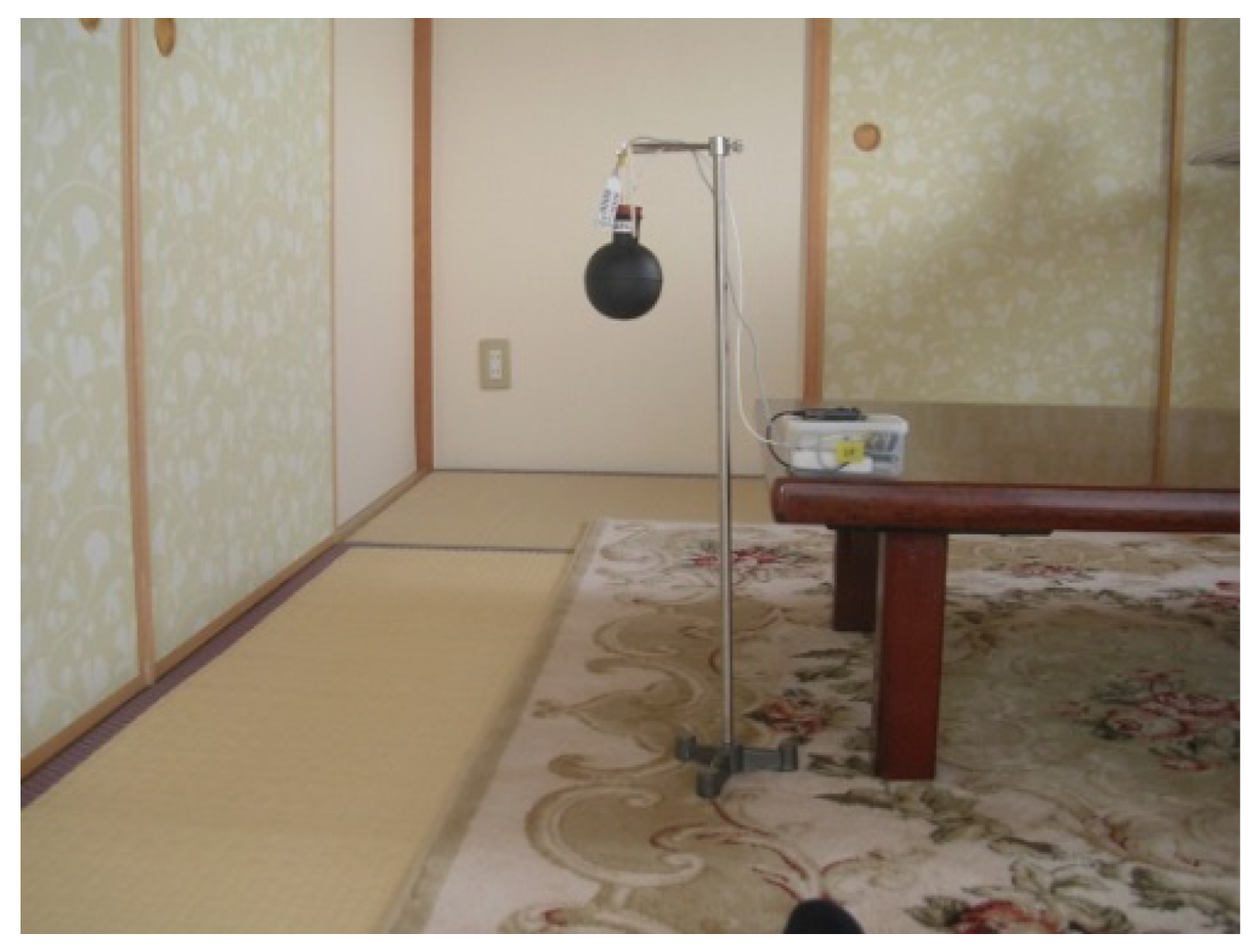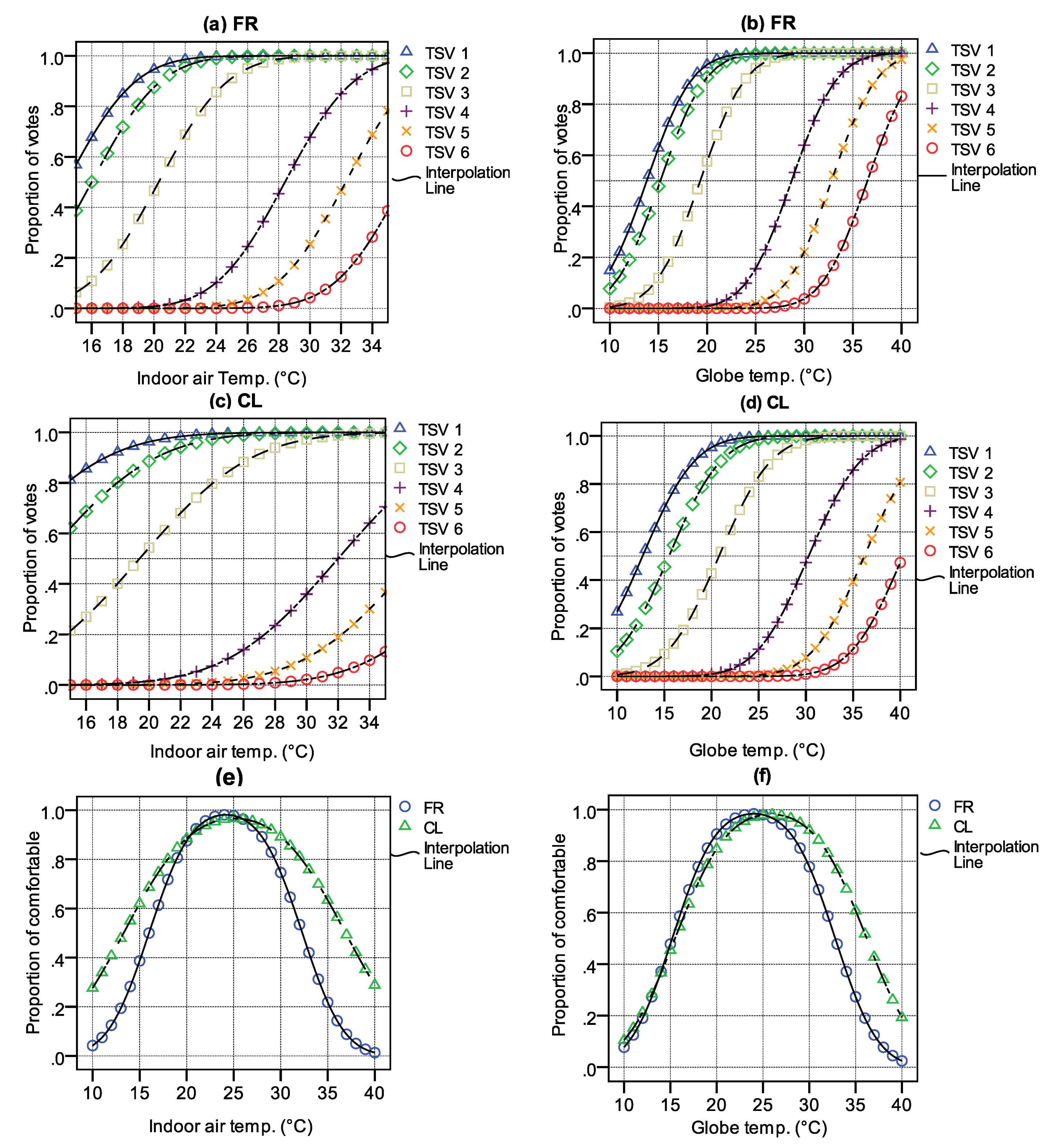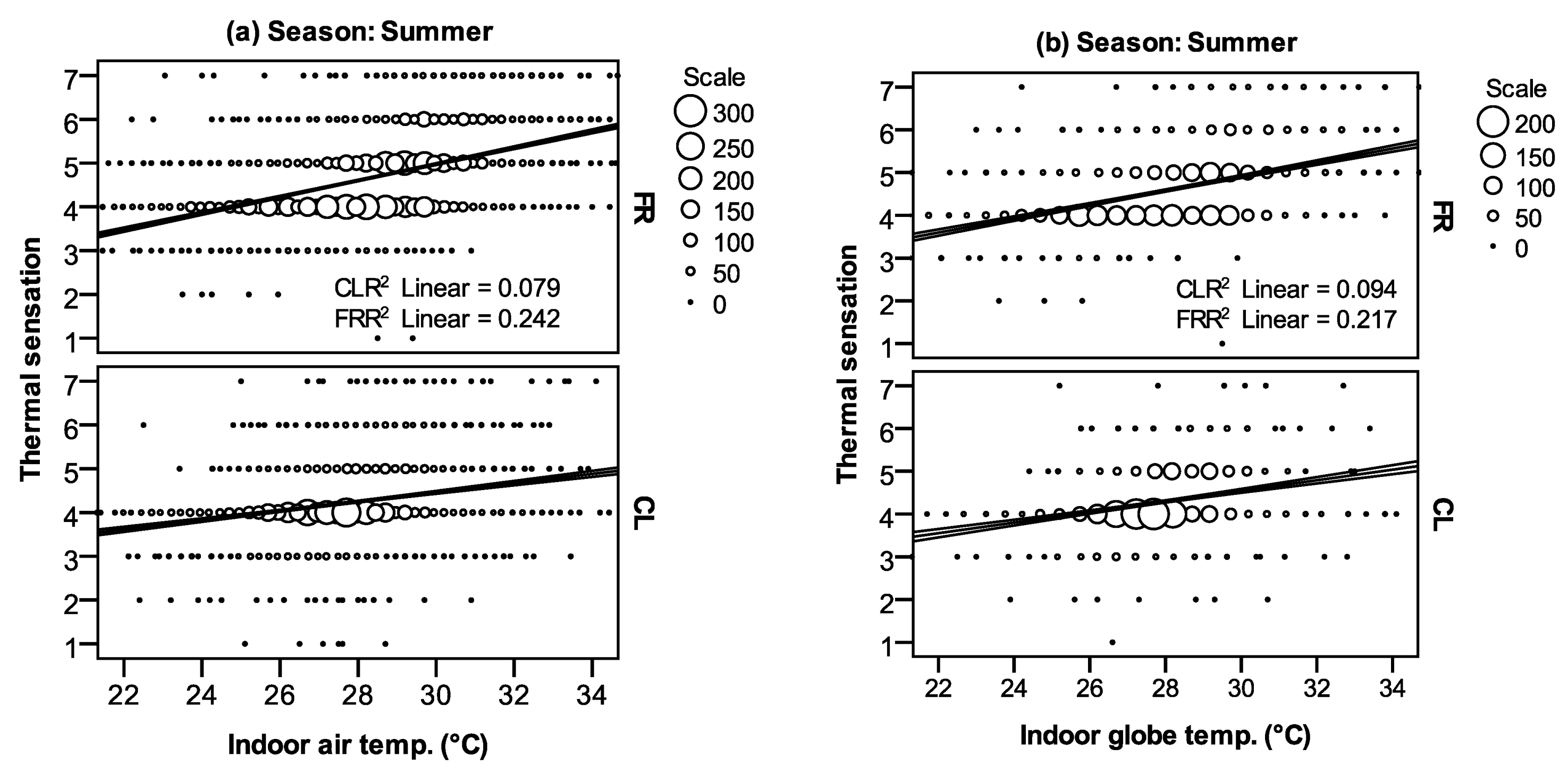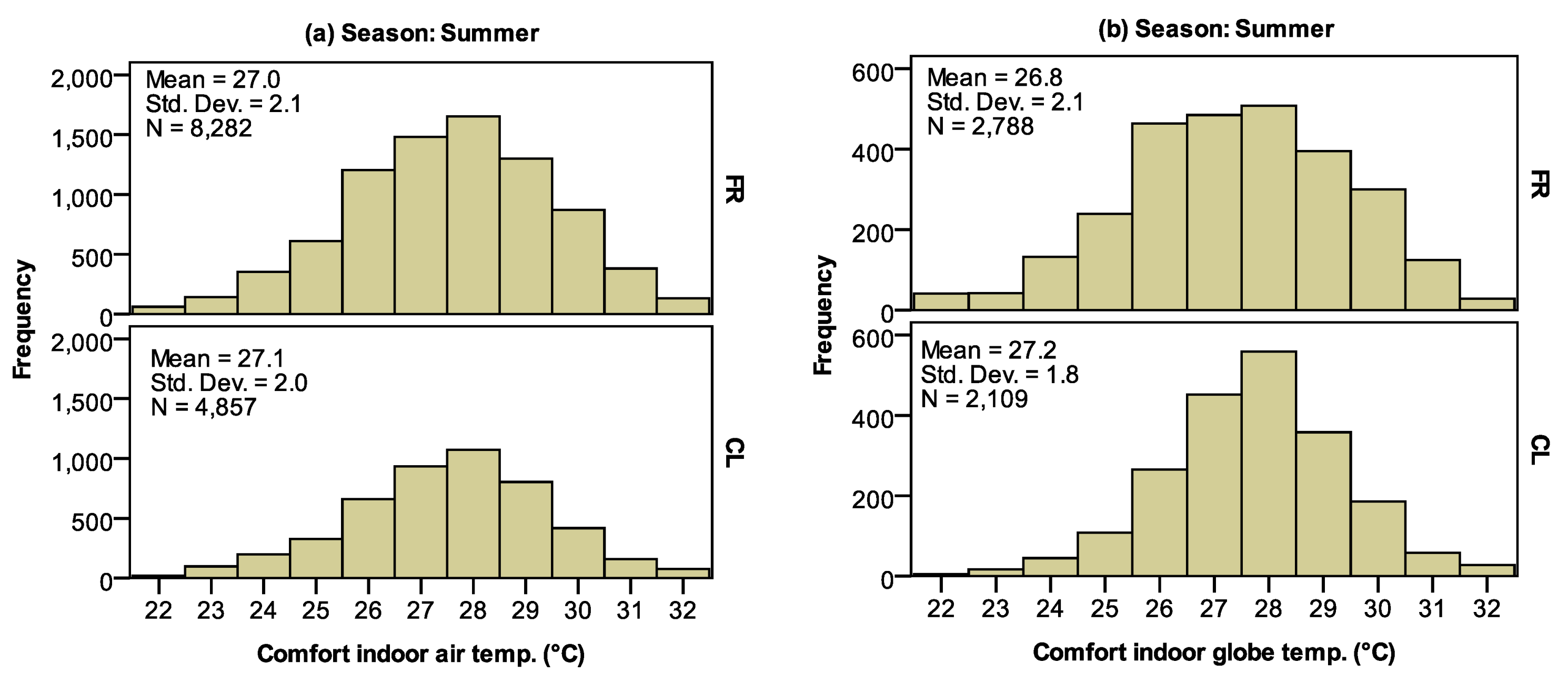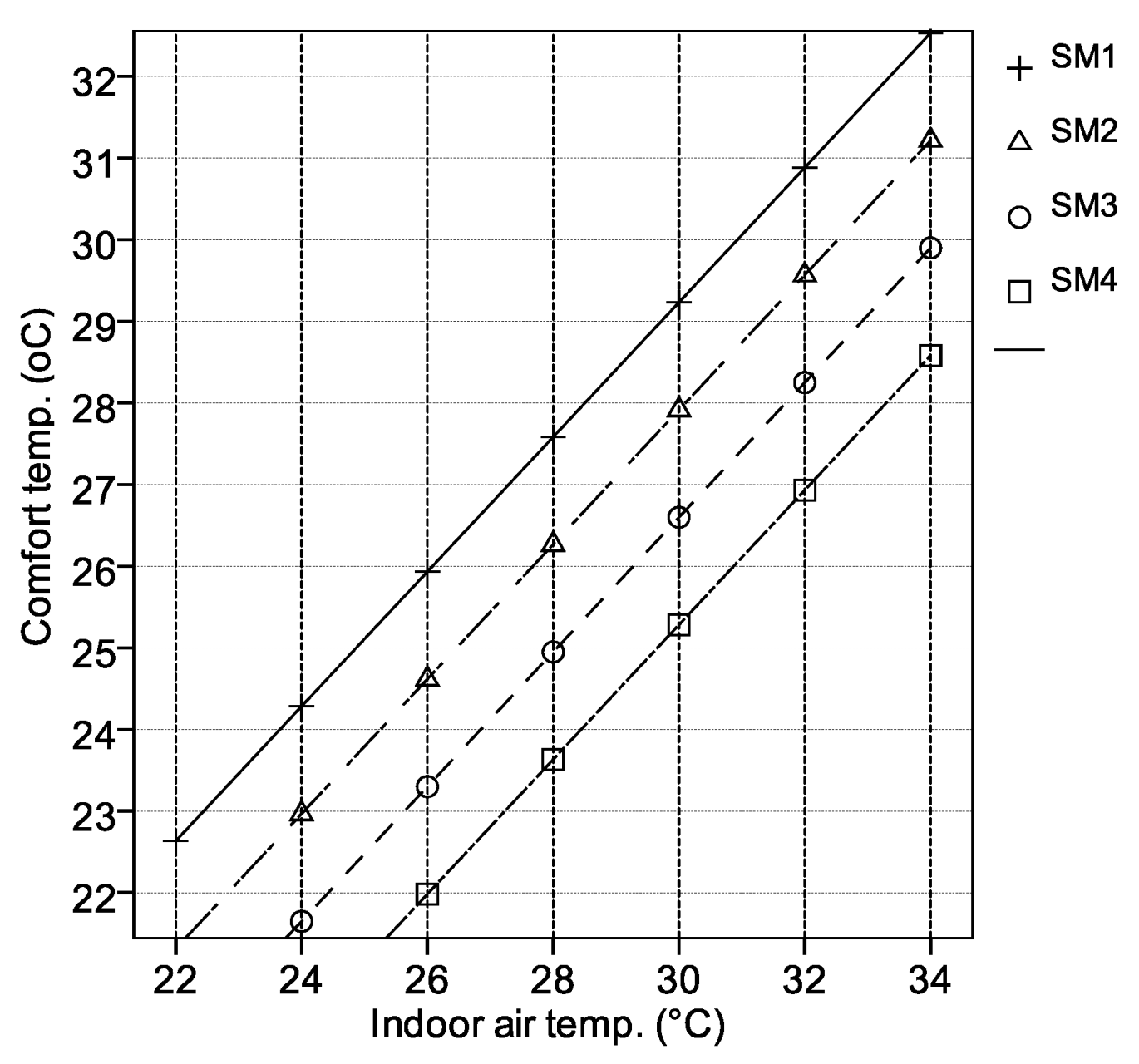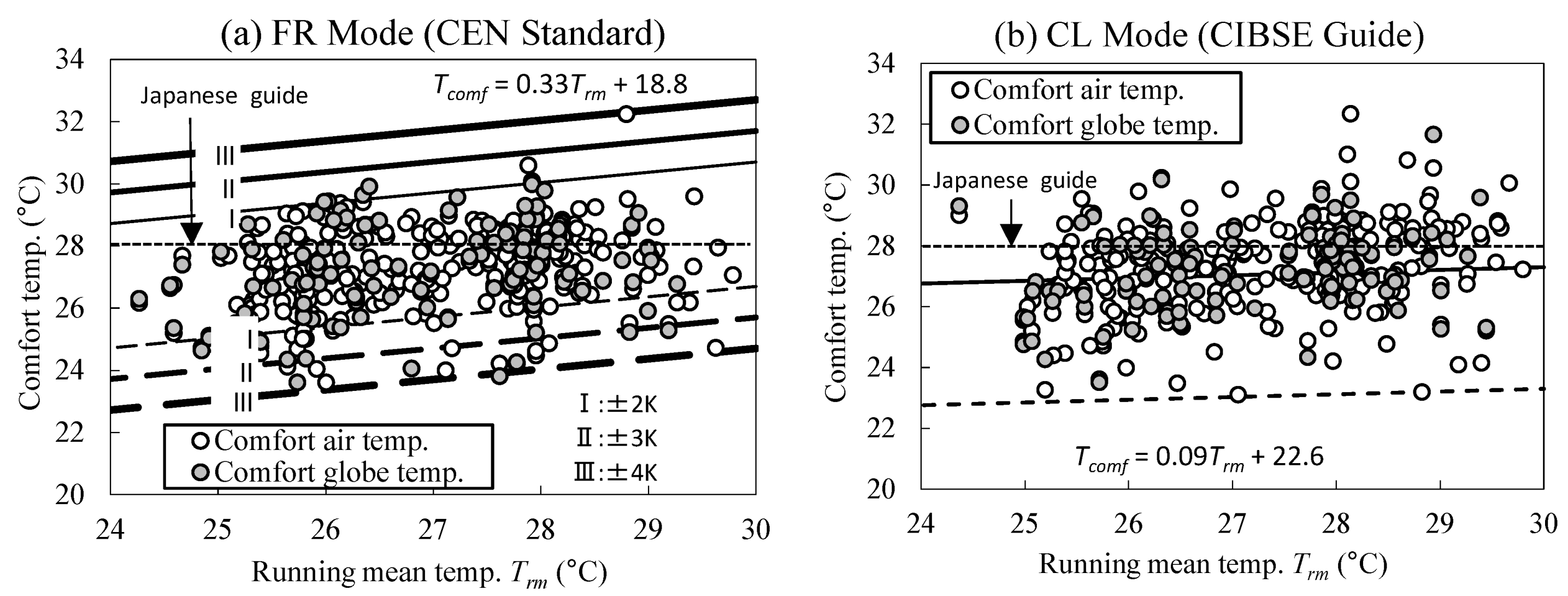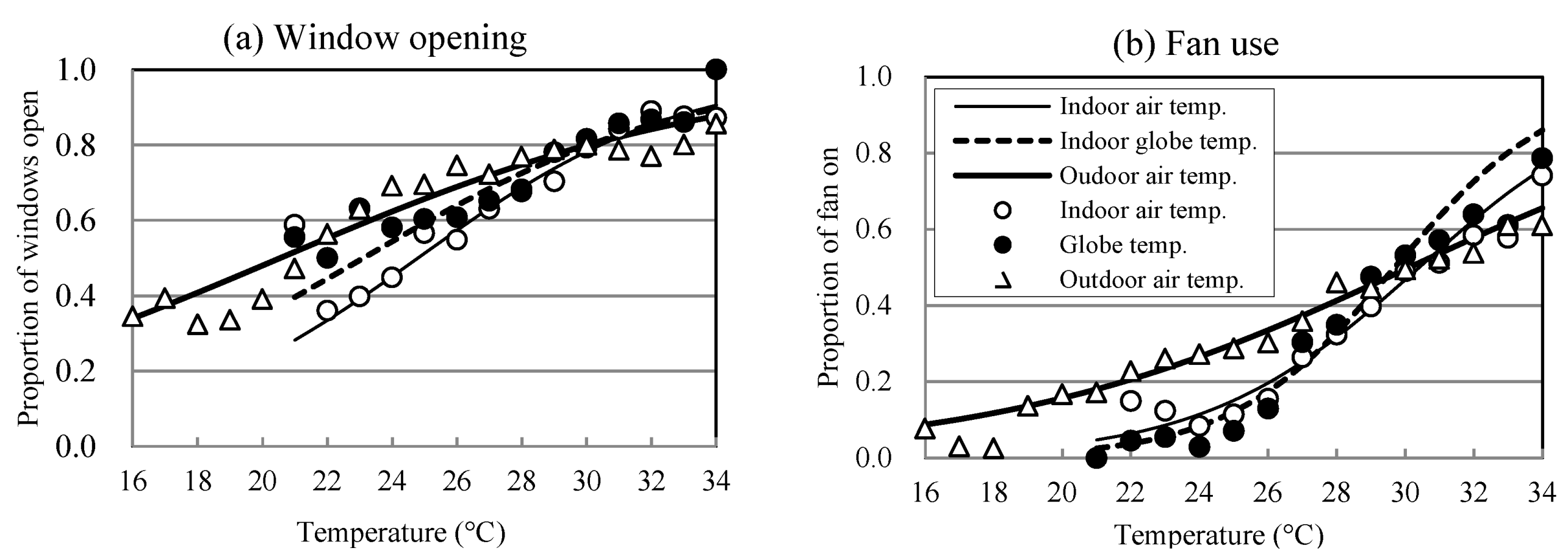3.2. Distribution of Temperature and Humidity
The monthly mean indoor and globe temperature is very similar in FR and CL mode (
Figure 2a), and the correlation coefficient is similarly high in both modes (
Table 4). In FR mode, indoor temperatures are higher than the outdoor air temperature. However, in CL mode, the indoor temperatures are lower than the outdoor air temperature, except in June. The Japanese government recommends the indoor temperature settings of 28 °C in summer. The results showed that the mean indoor temperature setting in CL mode was similar to the recommendation. The mean indoor relative humidity and absolute humidity are lower than the outdoor relative humidities (
Figure 2b,c). Due to the mechanical cooling, the mean indoor relative humidity or correlation coefficient of the CL mode is lower than the FR mode. The results showed that the relative humidity in FR mode is slightly higher than the standard: 60%. To predict the indoor air or globe temperature, regression analysis was conducted. The equations are given below.
CL mode:
Ti: indoor air temperature (°C);
Tg: globe temperature (°C);
To: outdoor air temperature (°C);
n: number in sample;
R2: coefficient of determination; S.E.: standard error of the regression coefficient;
p: significance level of regression coefficient. The correlation between the indoor and outdoor temperature of the FR mode is higher than the CL mode (
Figure 3).
Figure 2.
Monthly mean values with 95% confidence interval (Error bar): (a) temperature; (b) relative humidity; (c) absolute humidity.
Figure 2.
Monthly mean values with 95% confidence interval (Error bar): (a) temperature; (b) relative humidity; (c) absolute humidity.
Table 4.
The correlation coefficient.
Table 4.
The correlation coefficient.
| Mode | Items | Ti:To | Tg:To | Ti:Tg | RHi:RHo |
|---|
| FR | r | 0.77 | 0.76 | 0.99 | 0.45 |
| N | 8280 | 2785 | 2751 | 7924 |
| CL | r | 0.20 | 0.31 | 0.91 | 0.18 |
| N | 4860 | 2109 | 1911 | 4856 |
Figure 3.
Relation between the indoor and outdoor air temperature when voted (all raw data).
Figure 3.
Relation between the indoor and outdoor air temperature when voted (all raw data).
3.4. The Comfort Temperature
To predict the comfort temperature, regression analysis of the thermal sensation and indoor air or globe temperature was conducted (
Figure 5). The following regression equations are obtained.
CL mode:
C is the thermal sensation vote.
Figure 5.
Relation between thermal sensation and the temperature: (a) Thermal sensation and indoor air temperature; (b) Thermal sensation and indoor globe temperature.
Figure 5.
Relation between thermal sensation and the temperature: (a) Thermal sensation and indoor air temperature; (b) Thermal sensation and indoor globe temperature.
The regression coefficient for the FR mode is higher than that of the CL. When the indoor or globe comfort temperature is predicted by substituting 4 (neutral) for C in the Equations (6) to (9), this gives Ti = 24.8 °C or Tg = 24.4 °C in the FR mode and Ti = 25.5 °C or Tg = 25.6 °C in the CL mode.
The presence of behavioral adaptation in the data renders the evaluation of comfort temperatures suspect, tending to artificially lower the regression coefficients and therefore the estimates of the comfort temperature. There is therefore a problem in applying the regression method in the presence of adaptive behavior, as has been found in previous research [
2,
7]. So to avoid this problem the comfort temperatures have been re-estimated using the Griffiths method (in the next section).3.4.2. Griffiths Method
Griffiths [
22] suggested a way in which the comfort temperature can be calculated from a small sample of data. Griffiths made the assumption that the increase in temperature for each scale point on the thermal sensation scale was effectively 3 °C for a seven point scale [
23]. This means that for each thermal sensation vote away from neutral, he subtracted or added 3 °C from the actual temperature at the time to obtain the temperature that might be expected to result in neutrality [
23]. The detail of the Griffiths method can be found in the various publications [
9,
23,
24]. The comfort temperature is predicted by the Griffiths’ method which is given below.
where
Tc is the comfort temperature by Griffiths’ method (°C),
T is the indoor air temperature (°C) or globe temperature (°C) and
a is the regression coefficient.
In applying the Griffiths’ method, Nicol
et al. [
9] and Humphreys
et al. [
25] used the constants 0.25, 0.33 and 0.50 for a 7 point thermal sensation scale. We have also investigated the comfort temperature using these regression coefficients. The mean comfort temperature with each coefficient is not very different (
Table 8), so it matters little which coefficient is adopted. The comfort temperature calculated using a coefficient of 0.50 is used for further analysis.
Table 8.
Comfort temperature predicted by Griffiths’ method.
Table 8.
Comfort temperature predicted by Griffiths’ method.
| Mode | RC | Tci (°C) | Tcg (°C) |
|---|
| N | Mean | S.D. | N | Mean | S.D. |
|---|
| FR | 0.25 | 8282 | 25.7 | 3.1 | 2788 | 25.7 | 3.0 |
| 0.33 | 8282 | 26.3 | 2.5 | 2788 | 26.2 | 2.5 |
| 0.50 | 8282 | 27.0 | 2.1 | 2788 | 26.8 | 2.1 |
| CL | 0.25 | 4857 | 26.7 | 2.9 | 2109 | 26.7 | 2.7 |
| 0.33 | 4857 | 26.9 | 2.4 | 2109 | 27.0 | 2.2 |
| 0.50 | 4857 | 27.1 | 2.0 | 2109 | 27.2 | 1.8 |
The mean comfort indoor air or globe temperature by the Griffiths’ method is 27.0 °C or 26.8 °C in FR mode and 27.1 °C or 27.2 °C in CL mode (
Figure 6). The use of the Griffiths method brings together the neutral (comfort) temperatures for the air temperature and the globe temperature, again suggesting that it is more valid than the simple regression model.
Table 9 shows a comparison of the comfort temperature obtained in this study with existing research. The comfort temperature of the existing research is similar to this research.
Figure 6.
Comfort temperature predicted by Griffiths method: (a) Comfort indoor air temperature; (b) Comfort globe temperature.
Figure 6.
Comfort temperature predicted by Griffiths method: (a) Comfort indoor air temperature; (b) Comfort globe temperature.
Table 9.
Comparison of comfort temperature in summer with existing research.
Table 9.
Comparison of comfort temperature in summer with existing research.
| Area | References | Tempeature for Tc (°C) | Comfort Tempeature Tc (°C) |
|---|
| Japan (Kanto) | This study (FR mode) | Tg | 26.8 |
| Japan (Gifu) | Rijal et al. [2] | Ti | 26.1 |
| Japan (Kansai) | Nakaya et al. [1] | Top | 27.6 |
| China | Han et al. [3] | Top | 28.6 |
| Singapore | de Dear et al. [4] | Top | 28.5 |
| Malaysia | Djamila et al. [5] | Ti | 30.1 |
| Indonesia | Fedriadi and Wong [6] | Top | 29.2 |
| Nepal | Rijal et al. [7] | Tg | 21.1–30.0 |
| India | Indraganti [8] | Tg | 29.2 |
| Pakistan | Nicol and Roaf [10] | Tg | 26.7–29.9 |
| Iran | Heidari & Sharples [11] | Ti | 28.4 |
| UK | Rijal and Stevenson [12] | Ti | 22.9 |
3.5. Comfort Temperature and Humidity
The humidity is important in the hottest season. In a moist environment, it has been observed that people become uncomfortable with a smaller change in temperature than they do in a dry environment [
15]. To explore a possible effect of humidity, the comfort temperature is analyzed by relating it to the relative humidity, absolute humidity and skin moisture. The comfort temperatures were correlated with the indoor relative humidity, absolute humidity and skin moisture sensation (
Table 10). However, the correlation effect of the comfort temperature and relative humidity might have simply been attributable to the correlation between air temperature and relative humidity. So to further investigate the effect of humidity on the comfort temperature, multiple regression analysis was conducted for the FR mode.
(n = 8282, R2 = 0.47, S.E.1 = 0.007, S.E.2 = 0.002, p1 < 0.001, p2 = 0.001)
(n = 8282, R2 = 0.47, S.E.1 = 0.010, S.E.2 = 0.008, p1 and p2 < 0.001)
(n = 7868, R2 = 0.68, S.E.1 = 0.006, S.E.2 = 0.019, p1 and p2 < 0.001).
where Tci: Comfort indoor air temperature (°C); RHi: Indoor relative humidity (%); AHi: Indoor absolute humidity (g/kg (Dry Air)); SM: Skin moisture sensation; S.E.1 and S.E.2: Standard Error of regression coefficient for first and second terms; p1 and p2: Significance level of the regression coefficients of the first and second terms.
As may be seen from the equations, neither the relative humidity nor the absolute humidity had, in these data, an important effect on the comfort temperature. However, Nicol [
15] found that in a humid climate or in conditions when the relative humidity is high people may require temperatures that are about 1°C lower to remain comfortable. As for the skin moisture, Equation (13) shows it has a considerable effect on the comfort temperature, an increase of one category in the level of skin moisture reducing the comfort temperature by approximately 1.3 K (
Figure 7).
Table 10.
Correlation coefficient in FR mode.
Table 10.
Correlation coefficient in FR mode.
| Items | Tci:RHi | Tcg:RHi | Tci:AHi | Tcg:AHi | Tci:SM | Tcg:SM |
|---|
| r | −0.10 | −0.15 | 0.42 | 0.38 | −0.11 | −0.06 |
| p | <0.001 | <0.001 | <0.001 | <0.001 | <0.001 | 0.003 |
| N | 8282 | 2750 | 8282 | 2750 | 7868 | 2786 |
Figure 7.
Relation between the comfort temperature and the indoor air temperature for the four levels of skin moisture.
Figure 7.
Relation between the comfort temperature and the indoor air temperature for the four levels of skin moisture.
Nicol [
26] found that when indoor air temperature is 31–40 °C, increased air speed reduced the assessed skin moisture. Our results therefore imply that the evaporation of the skin moisture is important in raising the comfort temperature in Japan’s hot and humid season.
3.6. A Comparison with the Adaptive Model
It is well known that people adapt to the temperature of their accommodation, and thus comfort temperature has corresponding seasonal and regional differences in relation to the outdoor temperature [
20]. To predict such indoor comfort temperatures, the CEN and Chartered Institution of Building Services Engineers (CIBSE) proposed an adaptive model for office buildings. We compare our results with these adaptive models.
The running mean outdoor temperature (
Trm) is used in the adaptive model. It is the exponentially weighted daily mean outdoor temperature. It is calculated using the following equation [
14,
23,
27,
28].
where
Trm−1 is the running mean outdoor temperature for the previous day (°C),
Tod−1 is the daily mean outdoor temperature for the previous day (°C). So, if the running mean has been calculated (or assumed) for one day, then it can be readily calculated for the next day, and so on. α is a constant between the 0 and 1 which defines the speed at which the running mean responds to the outdoor air temperature. In this research α is assumed to be 0.8, a value previously found to be appropriate.
Figure 8 shows the relation between the comfort temperature and the running mean outdoor temperature. The six parallel lines in
Figure 8a show the acceptable zone of the adaptive model of CEN standard [
14]. The two parallel lines in
Figure 8b show upper and lower margins of the comfort temperature [
28]. The Japanese guide line is also shown in the figure.
Generally the comfort temperature of FR mode is within the acceptable zone of the adaptive model. As for the CL mode, the comfort temperature is higher than the CIBSE guide [
28] and Japanese guide line. The results showed that the residents are adapting to the higher indoor air temperature of the houses.
Figure 8.
Comparison with the adaptive model: (a) FR mode (CEN standard); (b) CL mode (CIBSE guide). Each point represents the monthly mean comfort temperature of each subject.
Figure 8.
Comparison with the adaptive model: (a) FR mode (CEN standard); (b) CL mode (CIBSE guide). Each point represents the monthly mean comfort temperature of each subject.
3.7. Occupant Behaviour
As we have shown in the previous sections, the residents questioned are adapting in summertime to higher indoor air temperature of the houses. Residents might be regulating their thermal comfort by using various adaptations: behavioral, physiological and psychological [
29]. This section focuses on behavioral adaptation. Nicol and Humphreys [
30] made use of logistic regression analysis to predict occupant control behavior in naturally ventilated buildings. We have also adopted the logistic regression method to predict the window opening and fan use in the living room. The relationship between the probability of windows being open or a fan in use (
p) and the indoor or outdoor temperature (
T) is of the form:
where exp(exponential function) is the base of natural logarithm,
b is the regression coefficient for
T, and
c is the constant in the regression equation.
The following regression equations were obtained in between the window opening or fan use and temperatures for FR mode.
Fan use:
where
Ti is indoor air temperature (°C),
Tg is indoor globe temperature (°C),
To is outdoor air temperature (°C) and
R2 is Cox and Snell
R2.
Even though the coefficient of determination is low, the equations are statistically significant. These equations are shown in
Figure 9. The predicted proportion of window opening or fan use is well matched with the measured values, as can be seen from the figure (the points shown are the proportions for the data in groups of width 1 K). The proportion of window opening or fan use is increased when temperature rises. The window opening behavior is similar to that found in previous research [
2,
24].
The regression coefficient for indoor air temperature or globe temperature is higher than the outdoor air temperature. It seems that the occupants respond more closely to the indoor temperatures than outdoor air temperature while operating the windows and fans.
Window opening and fan use might be important to increase the air movement and modify the indoor air temperature. Window opening is effective at increasing the indoor comfort temperature [
2,
31]. Theoretically, if wind velocity is 1 m/s, the indoor comfort temperature can be increased by some 3 or 4 °C [
15,
32,
33]. Nicol [
15] found that the presence of air movement can be equivalent to a reduction in indoor temperature of as much as 4 °C. When outdoor running mean temperature is 30 °C, the indoor comfort temperature when the fan is on is 31 °C which is 2.2 °C higher than when the fan is off [
24,
33].
Thus, the results showed that residents undertake behavioral adaptation to regulate their hot and humid thermal environment.
Figure 9.
Relation between the use of controls and temperature: (a) Window opening; (b) Fan use. Measured values were grouped for every 1 °C for temperatures. The grouped data for samples less than 10 are not shown.
Figure 9.
Relation between the use of controls and temperature: (a) Window opening; (b) Fan use. Measured values were grouped for every 1 °C for temperatures. The grouped data for samples less than 10 are not shown.
